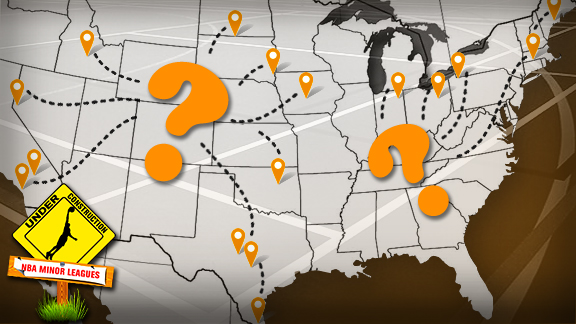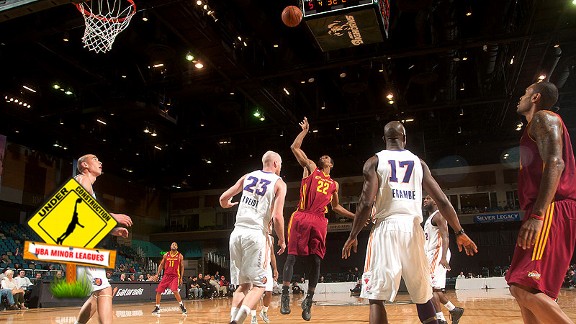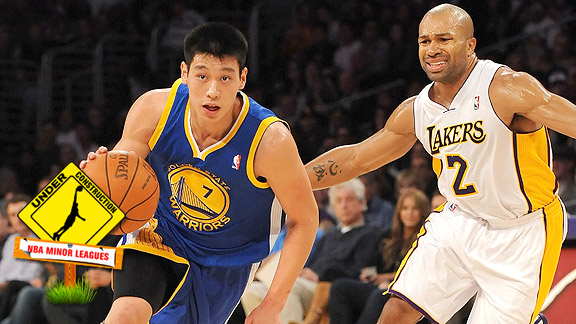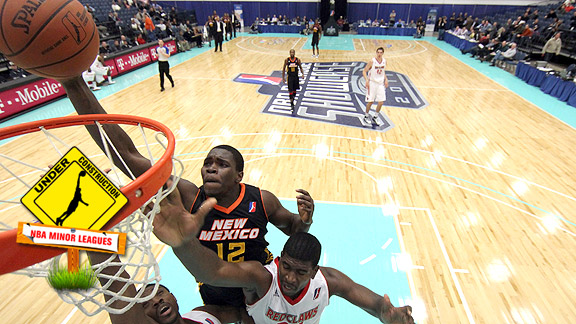Diamonds in the rough
Full minor leagues could make draft deeper and unearth another Jeremy Lin
Originally Published: October 4, 2012
By Chad Ford | ESPN Insider
The Warriors vow not to let the next Jeremy Lin get away by owning their own D-League affiliate.
Editor's Note: This is the fourth installment of a five-part series this week examining the possibility and impact of a full NBA minor league system similar to the model used in Major League Baseball. Today we explore what impact such a system would have on the NBA draft.
It's December 2010.
Joe Lacob and Pete Gruber had just purchased the Warriors. The team had made the playoffs only once in the past 16 years and Lacob came in determined to change the entire culture of a franchise.
One of Lacob's first acts (before he even officially took over as owner) was to persuade the past ownership team to sign an undrafted free agent, local product Jeremy Lin, to a non-guaranteed contract shortly after the 2010 draft.
Lin, who played high school ball in Palo Alto before going to college at Harvard, was a favorite of Lacob. Warriors fans needed something to cheer for and signing Lin was, if nothing else, a tip of the hat to hardcore fans.
Lacob also completely revamped his management team, bringing in former agent Bob Myers, NBA legend Jerry West and his own son, Kirk, to bolster the front-office credentials.
Myers was a popular choice among NBA people in the know. He was smart, had excellent relationships with the other GMs in the league and knew both the basketball and business side of the game.
West was considered by many to be the best talent evaluator in the NBA. Maybe ever.
Kirk, on the other hand? The newly minted Stanford grad had spent the past several summers doing internships in the NBA. Now that his father owned the Warriors, he was getting his first real job in the NBA. At age 22, he was named the team's director of basketball operations.
His first assignment inside the Warriors was to attend the D-League draft of the Reno Big Horns -- the Warriors' D-League affiliate team.
"It was a cool experience," Kirk Lacob recalled. "It was the first draft I'd ever been part of. Eric Musselman [Reno's head coach at the time] started guiding us through what the D-League could be. I got a comfort level with it. We started talking about how useful the D-League could be to us in terms of player development."
Seventeen games into his rookie season, Lin was averaging 1.9 ppg in 8.5 mpg. The Warriors loved his talent. But the transition from the Ivy League to the NBA was proving a little too much.
The Warriors decided to give Lin a chance to play in Reno.
"With an asset like Jeremy, we thought it would be a great fit," Lacob said. "He could get the playing time he needed and we could develop a player we truly liked."
“
With an asset like Jeremy, we thought it would be a great fit. He could get the playing time he needed and we could develop a player we truly liked.
”
-- Kirk Lacob, Golden State Warriors assistant general manager
Lin might have thought at the time he was being demoted. But in reality, the seeds of Linsanity were being sowed. He scored 10 points in his first game. He had 21 points in 20 minutes in his second one. By his fourth game, he was good enough that the Warriors recalled him to the major leagues.
Lin immediately went on the inactive list, however, and by January he was back with Reno -- scoring points and landing a spot on the D-League Showcase first team. In 20 games, he averaged 20.4 ppg. The Warriors recalled him again in February, but again, Lin played sparingly.
Both Lin and the Warriors credited the D-League experience with helping Lin regain his swagger. But with the team trying to win now, the playing time just wasn't going to be there. A new head coach and the NBA lockout combined with an ill-fated attempt to land restricted free agent DeAndre Jordan ended Lin's run in Golden State.
The team waived him on the first day of training camp to make cap room for an offer on Jordan before Lin had a chance to play for new head coach Mark Jackson. It turned out to be a mistake for the Warriors.
One they are counting on never happening again.
"Jeremy benefited from his time in Reno," Lacob said. "But we began to understand that for the D-League to really work for us, things needed to change. We wanted more more control. We wanted to be able to control who the players around Jeremy were. The type of system he was playing in. His playing time. It worked out for Jeremy, but we needed to find a way for it to work for us, too."
After exploring a number of different options, the Warriors decided that the only real way to turn a D-League team into a true farm team was to completely own the team and eventually move it close to home.
At the time, only four teams, the San Antonio Spurs, Oklahoma City Thunder, Dallas Mavericks and Houston Rockets, owned their D-League teams. All are showing various forms of success with it. The Warriors intend to take their sole ownership even further.
"If we can control every aspect, we can try out different things for player development," Myers said. "We can develop coaches, front-office staff, ticket sales. We wanted to own everything."
This perspective is important to keep in mind, because when the Santa Cruz Warriors step foot on their home court for the first time on Dec. 23, they might be providing us with a glimpse into the future of the NBA.
And understanding how an old IBA team from North Dakota landed in Santa Cruz, Calif., illuminates the path that more and more NBA teams are embracing as they look for anything that might give them a competitive edge over the other 29 teams in the NBA.
Owning the farm team
On June 28, 2011, the Warriors bought the Dakota Wizards for roughly the cost of a first-round draft pick. Joe Lacob tapped Jim Weyermann, a minor league baseball guru and former president of the Class-A San Jose Giants, to be the president of the team. Weyermann's job was to teach the Warriors everything he knew about how to make a successful farm team and to find a spot for the Wizards to relocate to Bay Area.
Kirk Lacob was promoted to assistant GM of the Warriors and concurrently as GM of the Wizards. His task was to find a way to integrate what the Warriors were doing in Oakland with what the Wizards were doing in North Dakota.
They wanted better communication between GMs, coaches and scouting staffs. They wanted to make two separate organizations one with a goal of improving player development.
Kirk Lacob, who also embraces sports analytic models, says that their research is clear. The Warriors can get a competitive advantage and a huge return on their investment if they put more effort into player scouting and development.
"If you draft a player in the top five, he's got a great chance of sticking in the league. If a player is drafted between six and eight he still has a pretty good chance. But after that, players drafted between nine and 30 have barely a better chance of sticking in the league than second-round picks.
"It's shocking really," Lacob said. "We want to improve our chances and we think the best teams do that through player development. If we can increase our young players' chances of making the league from say 12 percent to 25 percent, it will be worth the investment."
[+] Enlarge
Jerome Miron/US Presswire
Perhaps given time to develop skills in Golden State's system, Jeremy Tyler (left) is now their starting center.
In their inaugural year, the Wizards were a bit of a testing ground. The Warriors sent Jeremy Tyler there for a stint and developed an undrafted player they liked, Edwin Ubiles.
Tyler is the poster child for the need of a NBA farm system. Tyler left the United States after his junior year in high school to play pro ball in Israel. Despite his natural talents, he wasn't ready for the leap and his stint in Israel ended in disaster. The next year he spent in Tokyo playing against inferior competition. By the time of the NBA draft in 2011, every team in the NBA was afraid of Tyler. He had the size and athletic ability to be a NBA star. But he was incredibly raw and there were serious questions about his maturity and his work ethic.
Despite lottery type talent, Tyler slid to the 39th pick. The Warriors felt if they had the space to develop him, he might be worth the risk.
"When you are drafting a player, especially in the second round, you know there's a good chance he won't get playing time," Lacob said. "And if he does, he won't be confident trying to expand or improve his game. He's always looking over his shoulder, afraid to make a mistake.
"However, with a D-League team in place where you control all of the elements -- it increases your ability to take risks on kids who aren't ready for the NBA but could be someday.
"We had all the same information everyone else did on Tyler before the draft. We had our reservations. We had heard the same stories. We learned everything we could. The difference for us is that we thought we had a player development process in place to let him succeed. And if he developed, he could help us."
In February the Warriors put their experiment to the test. They sent Tyler, who was playing sparingly, to North Dakota to get him some confidence.
"He didn't get to go to college. The situation he was in for the last two years wasn't ideal," Lacob said. "He wasn't playing for us. He was working hard with the team. We had him working on a little jump hook and things. But it's hard to be a better player without playing time. He got a chance to do that in the D-League."
Tyler played a total of five games for the Wizards. He averaged 15.6 ppg, 7.8 rpg and shot 59 percent from the field in 30 mpg. By the end of the season, he was the Warriors' starting center and averaging 12 ppg and 8 rpg.
Whether Tyler's increased playing time is a testament to Tyler's development or the Warriors' nose dive at the end of the season is debatable. But the real test is coming this season. In May, the team began the process of moving the Wizards to Santa Cruz -- and renaming them the Warriors -- for the 2012-13 season.
With the D-League team only 75 miles away, and a new CBA rule in place that allows teams to make unlimited assignments to the D-League for the first three years of a player's career -- the Warriors have big plans.
"When you own your own team and it's close to you, it opens up a lot of options," Myers said. "A rookie can practice with the team in the morning, drive down to Santa Cruz and play 30 or 40 minutes in a D-League game and be back the next morning for practice with the team. It gives us the ability to keep a player close, keep them surrounded by our coaches and players, and still give them a chance to go get significant playing time. Since our D-League coaches are just an extension of our NBA coaches, we run the same system, we are on the same page and our ultimate goal isn't just to win D-League games, but to develop players. It opens up a significant opportunities for us."
Protecting the investment
As more teams embrace the concept, and as the NBA and Players Association change the rules to accommodate teams such as the Warriors, it opens up a whole new world for the draft, rookie contracts and how the league scouts.
If teams own their minor league team, they will want to own the rights to more young players. To make that happen in a way that works for both the teams and the players, new forms of contracts will have to be developed.
Currently players drafted in the first round are on rookie scale contracts. Second-rounders have to sign for at least $500,000 -- the league minimum. Once signed, teams own the players' rights for the duration of the contract.
[+] Enlarge
Joe Robbins/Getty Images
The Warriors nearly lost Edwin Ubiles to the Washington Wizards.
D-League contracts, on the other hand, have a starting salary that tops out at around $25,000. Players can be called up by any team in the league if a player is on a D-League contract. That's how the Warriors almost lost a promising young prospect, Ubiles, when the Washington Wizards signed him to a 10-day contract in March. Ubiles' contract ended after that 10-day stint, and he returned to the Dakota Wizards. But had Washington kept him, Golden State would've lost out.
A number of GMs said that at some point, a middle ground will have to be made for teams that want to retain the rights to their D-League players without breaking the bank. Some are calling for two-way contracts that allow teams to own the rights of D-League players at cost of say, $100,000 per year. It's a big pay raise for some D-Leaguers, but it protects teams that want to invest in the development of players outside their regular 15-man roster.
"For this system to work, there has to be a reason to invest in players," Myers said. "We have to protect the investment. If a couple of teams don't take the lead, then the teams who doubt it won't join in."
Changes to the draft?
Sole ownership of a D-League team could lead to teams being more aggressive in picking up second-round picks, for example. It might convince even more underclassmen to leave college early (or skip it altogether) to develop a relationship and a training regime with a particular team, increasing the depth of drafts. It might even lead to the NBA draft expanding a round or two.
In the first two rounds of the NBA draft, teams typically end up focusing on drafting players who are either elite talents or who can help you right now. If you added a third round, an idea that the Warriors say they are in favor of, teams could use it as a developmental round where they target players who aren't ready, but could be someday.
It might also begin to change the way teams scout. Currently, NBA teams keep a database of between 100 and 150 players that they actively scout. The goal on draft night is to narrow that list to 60 players. The leftovers are for summer league squads or training camp rosters. But with a viable farm team in place, it might force scouts to assess talent a little differently.
"It gives you a broader perspective," Lacob said. "You may like a guy from the Summit League, but you feel like the gap between the competition is just too great for him to overcome in a short period of time. With a good D-League system in place, you can send them there to learn your system, play against better competition and to get their confidence up. In a year, you might have a guy like Lin, who couldn't just make the leap from Harvard to the NBA. He just needed some time to adjust and get his confidence. I think it opens up a lot of possibilities, especially for some of the players from smaller schools who have the talent, but need the time to adjust."
Leveling the playing field?
Overall, sole ownership of a D-League team embraces the idea that for teams, especially small-market ones, to compete with the big markets, they have to get smarter about how they handle their most valuable resources -- young players.
Not everyone is in. In fact, a number of the GMs and scouts I spoke with in the league have barely given it much thought. Many believe there just isn't that much talent out there and don't believe the effort of running and coordinating a farm team is worth the return in a league that has only 15 roster spots.
"Look, there are about three to four team-changing players in every draft," said one NBA GM who wanted to remain anonymous. "Maybe another five or six are role players. Everyone is mining the same rock. Everyone is after the same diamonds. Throwing a bunch of money at a D-League team isn't really going to change things with the draft or the NBA. God bless them. They're young and think they can reinvent something. I've been around the block a few times. Been around this one, too. I think they'll end up where they began. Jeremy Lin is an outlier. He's not the norm."
Perhaps. But the Warriors think they have seen the future and are embracing it with open arms.
"We are all-in," Myers said. "The negative stigma surrounding the D-League is evaporating. Agents and players want to play in it. Most of the successful organizations in the NBA have developed their own players. Knowing you have a team you own in close proximity; knowing that you can control the culture, the coaching and the system -- it's a big positive. You don't get better playing basketball unless you play."
Just ask Jeremy Lin.




